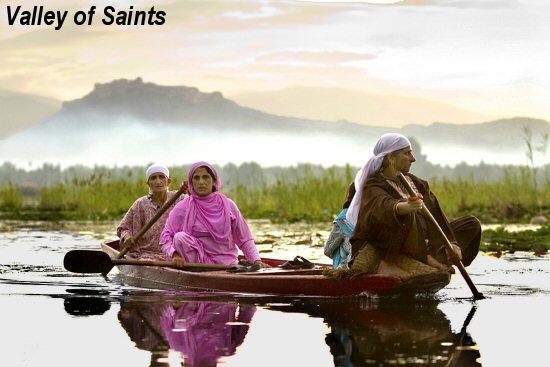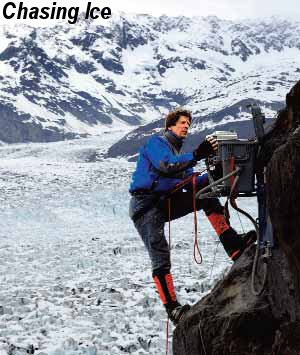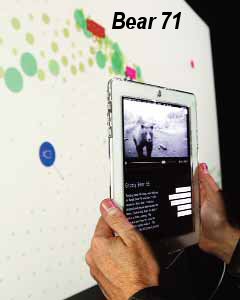SEJournal Online is the digital news magazine of the Society of Environmental Journalists. Learn more about SEJournal Online, including submission, subscription and advertising information.
Feature
By JOANN VALENTI
Sundance screens documentaries on pesticides, climate change, nuclear power and more
|
|
|
Women living on the edge of a dying lake in Kashmir take their wares to a boaters' market. "Valley of Saints", co-winner of the Sloan science award, also won the Audience Award at the 2012 Sundance Film Festival. © PHOTO BY YONI BROOK. |
Indie films screened at Robert Redford’s annual Sundance Film Fest in the mountains of Utah set the agenda for movie festivals all over the country, all year. The best move on to Academy Award nominations, win Oscars, top the showcase for major cable TV outlets and pull in worldwide audiences. SFF, from humble beginnings in the ’80s, is now a major route to success both for filmmakers and film lovers. When you add in the documentaries and short films screened, the SFF 2012 program served up 181 independent efforts to reach distributors and maybe a mass audience.
Not unexpected for this fest of film rebels, many of this year’s program, especially in documentaries and shorts, focused on the fading pulse of the American Dream, international unrest and the power of protest.
For example, a not-to-be-missed doc from Sweden, "Big Boys Gone Bananas," brilliantly captures the aftermath of the 2009 doc "Bananas," as Dole Food Inc. sues the filmmaker, controls U.S. media reports (very scary) and threatens anyone trying to screen the film. All this over the story of Dole’s use of a pesticide, later discontinued, and accusations by Nicaraguan workers of poisoned people and land. Spoiler alert: the little guys win against the multi-national corporate giant.
Although the Swedish parliament, conservatives and liberals (imagine that!) formally request Dole to stop their threats on freedom of speech, U.S. media come off looking incredibly sucked in by a massive PR machine. “It’s terrible [to be sued],” Swedish filmmaker and former journalist Fredrick Gertten told me. “It’s against the meaning of democracy.” Gertten said he wants balance in his stories. “It was important to let the audience listen to the best arguments from Dole,” he said. “I believe in transparency. I know they [international corporations as well as his blog fans] follow what I do. I have no secrets,” he said.
When I asked how he felt now about American journalists who for a year after the story ran with the PR spin, he noted the stress of time pressures on reporters but worried more that “it takes a lot to go against the tide.” In this case, the L.A. Business Journal set the agenda based on facts, later proved false, created by Dole that deflected the real story. Ultimately, people are intelligent, they can take a stand and truth will win even under attack, Gertten said.
As if on cue, yet another suit was filed on opening day against a filmmaker whose doc focused on what was to be the largest — read most obscene — house in the United States, being built in South Florida. The billionaire allegedly went into foreclosure. The audience might relate to the housing bust issue, then wince at the morality of more bathrooms with more square footage in one house than total space in a five-star hotel. By fest end, the suit disappeared and the film — "The Queen of Versailles" — won a directing award.
|
|
|
"Chasing Ice" features photographer James Balog, founder of the Extreme Ice Survey, shown here adjusting a remote camera above an Alaskan glacier. (See Glacier Chasers — SEJournal cover story, Summer 2009. PHOTO: © JAMES BALOG. |
"Chasing Ice," a serious improvement over "Inconvenient Truth"’s effort to tell the climate change story, brings massive calving icebergs from around the globe onto the screen through the lens of National Geographic photographer James Balog. The Extreme Ice Survey (EIS) project set up 30 cameras in Alaska, Greenland, Iceland, the Alps, Canada, Bolivia and Glacier National Park in Montana (soon to be known as Glacierless National Park). Filmmaker Jeff Orlowski won an award for Excellence in Cinematography.
Two years into making the doc "The Atomic States of America," the Fukushima accident sent filmmakers Sheena Joyce and Don Argott back to their nuclear experts who had told them no one would pay attention to the potential danger of nuclear power until we had another Three Mile Island or Chernobyl. Their film offers a before-and-after perspective on the shift in public perception of nuclear’s risk.
This year the annual Alfred P. Sloan Award for accurate representation of a science issue, technology, or portrayal of scientists or engineers recognized two films, both, as per the award’s requirement, feature films. You will soon see "Robot and Frank" starring Frank Langella, Susan Sarandon, James Marsden and Liv Tyler in theaters. Sony Pictures Worldwide and Samuel Goldwyn Films acquired rights to this “in the near future”mechanical solution to elder care for $2 million.
Award co-winner "Valley of Saints," also the winner of the Audience Award for World Cinema Drama, comes from India and features a dying lake in Kashmir.
Even a one-time SEJ member, author Phil Shabecoff, saw his book A Fierce Green Fire morph this year into a lengthy documentary by the same name. A fifty-year history of the environmental movement is retold via archival footage and a showcase of notable talking heads, among them Shabecoff, the late Stephen Schneider and reps from the bigger enviro NGOs. [Note from a retired academic: It would take two class sessions to expose students to this film; they can read the book on their own time.]
|
|
|
"Bear 71" from Canada featured over 11 years of video clips from trail cameras following a grizzly bear that were embedded in an online grid at a festival installation. PHOTO BY JEAN SEBASTIEN DEFOY, NATIONAL FILM BOARD OF CANADA. |
For me, in my second decade of covering SFF, the most outstanding look into what’s ahead came from the New Frontier art installation "Bear 71" from Canada. Redford noted in the opening press conference that creative tools are mixing and new hybrids are emerging to show us what’s in the future. "Bear 71" clearly forecasts what’s coming. Over a decade of park rangers’ trail cam footage, an online map/grid of Banff National Park and a narrative voice created for a female grizzly invite user participation. "Bear 71" is an exciting interactive lesson in a real animal-human interaction.
As the star, the bear herself, repeats her mantra, “Don’t do what comes naturally,” a modern day fable emerges from the world of media scientists, a new breed combining artist/filmmaker/journalist/game designer. It’s bioelectric architecture, computer technology and more creating a cyborgish future normal. Seriously. Normal is not what it used to be. Go here.
Access to more information on SFF 2012 films can be found at sundance.org. Also see sundance.org/apps.
JoAnn Valenti, Ph.D., spends her retirement working from her home in Tampa, FL. Emerita Professor seems to mean nothing ever stops.Probably not such a bad deal.
* From the quarterly newsletter SEJournal, Spring 2012. Each new issue of SEJournal is available to members and subscribers only; find subscription information here or learn how to join SEJ. Past issues are archived for the public here.















 Advertisement
Advertisement 



